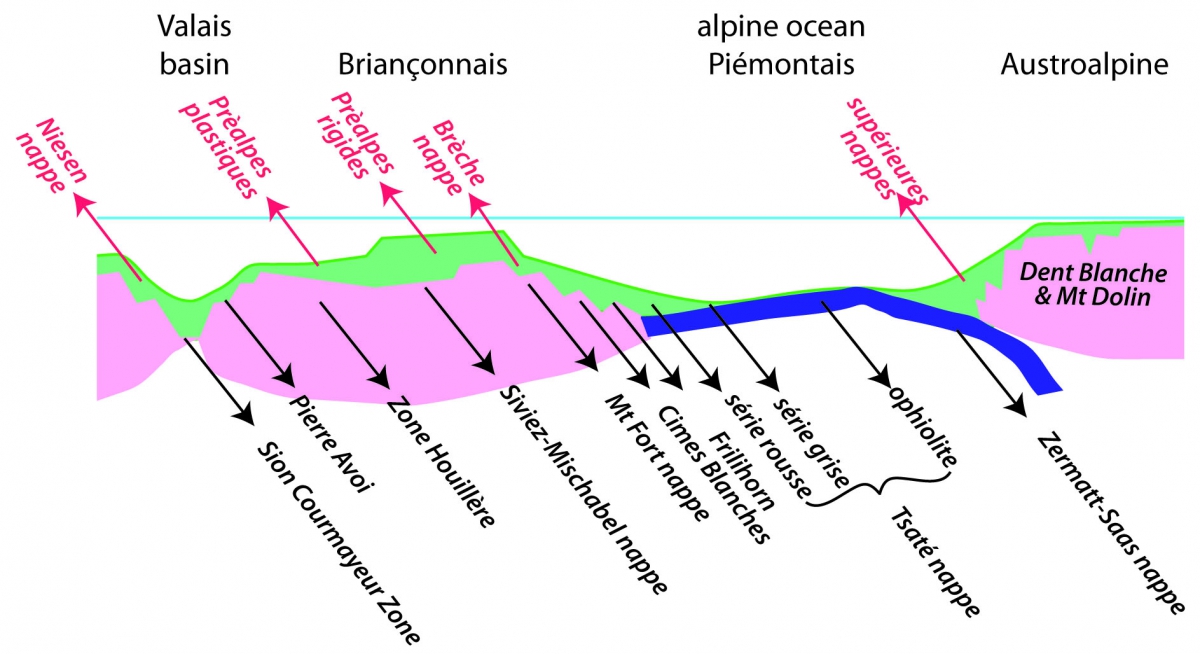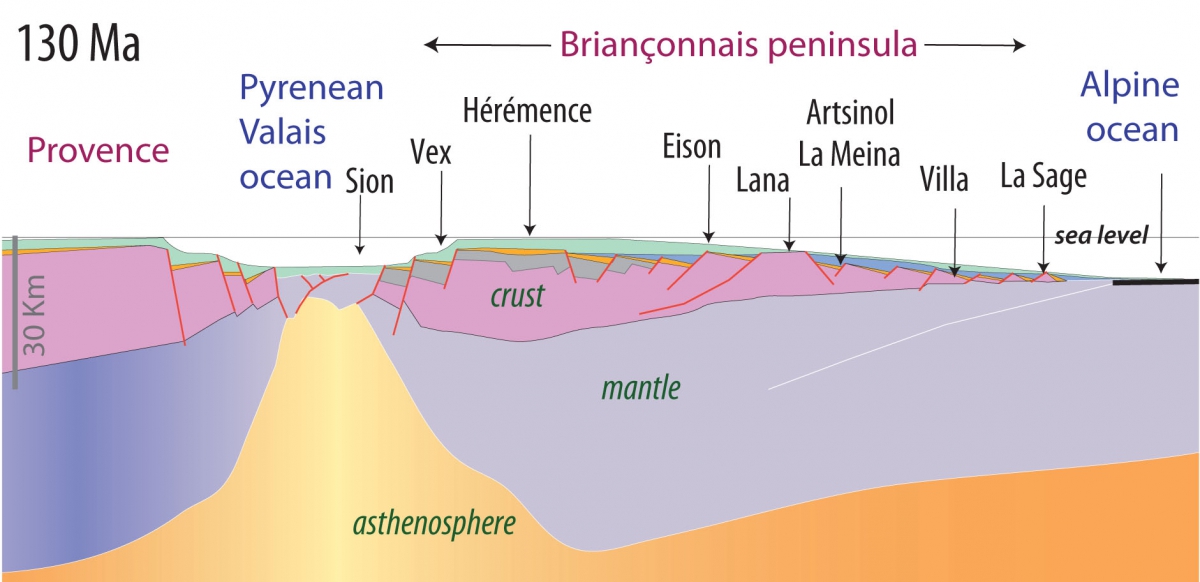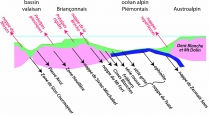Relics in the Val d'Hérens
In the Val d’Hérens, however, sufficient information exists to enable the geological reconstruction of the Briançonnais micro-continent in this region.
- At the far south of the Val, the Dent-Blanche massif represents the African continent, or plate.
- Between Ferpècle and La Forclaz and around the Aiguillles Rouges of Arolla, remnants of the Alpine Ocean exist in the form of serpentinites and basaltic lavas.
- Between La Sage and Evolène the remains of tilted blocks from the European continental margin
- Between Lana to Sion, what is left of the Prealps basin, some sediments are still present such as the dolomitic cliffs at the entrance of the Val.
The diagram illustrates tectonic movements in the Valais:
- subducted tectonic units (black)
- detached tectonic units transported to the Prealps (red)
The subducted units finally brought up to the surface represent a very small percentage of the Briançonnais domain. Firstly this is because the majority of this micro-continent (pink) was forever subducted into the Earth’s mantle.
Secondly, the still visible units have been severely eroded during the last million years, mainly due to the last glaciations, transformed into grains of sand they have disappeared forever.

On the reconstructed cross-section of the region 130 Ma ago, the present localities of Val d’Hérens are indicated (see also field trip E and the cross-section on the left). The Pyrenees-Valais Ocean separated the Briançonnais Peninsula from Provence where it was initially attached (reconstruction 130 Ma, see movie 1’01’’). To the right the remains of the 500 km wide Alpine Ocean, between La Forclaz and Sépec, exist as serpentinites, metagabbros, and matabasalts of the Tsaté Nappe.

These oceanic terrains form a strip from the Tsaté Pass, through La Forclaz, Les Haudères and towards the Aiguilles Rouges in Arolla.
NB: South of this oceanic strip the Dent-Blanche Nappe represents the Austroalpine domain and the southern ocean margin (see chapter 5). The main constituents are gneiss (granite) and Lower Permian metagabbros (Mt Collon). The Mont Dolin series, made of Triassic dolomites and Jurassic rift series marble and breccias is situated on this Permian base.
The Frilihorn and Cimes Blanches units, tilted blocks (figure 8) from the northern ocean margin, can be found in the surroundings of La Sage and Villa (see field trip E). Breccias deposited on these blocks can be found on the left bank of the Borgne River, between La Meina and the Pic d’Artsinol. The Lana spur, or l’Ala, represents a part of the former Jurassic rift shoulder. The Prealps basin was located behind the rift shoulder and remnants exist in the Val d'Hérens between Evolène and Sion. Two examples are the the Barrhorn series in the Siviez Mischabel nappe and the cliffs between Sion and Vex and around Nax in the Houillère Zone.
The majority of these Mesozoic sediments is now in the Vaud and Fribourg Prealps. Evaporites, salt and gypsum, enabled the detachment within the Triassic series. The rocks that remained in the Val d’Hérens have much older origins. They are the Alpine basement rocks (containing some Triassic rocks, orange on the cross section) that supported the Mesozoic basin. The Alpine basement is divided into two series, Permo-Carboniferous sedimentary rocks and the Variscan basement proper, they are now extremely folded and refolded.
Permo-Carboniferous rift sediments: (grey on the cross-section) made of continental detritic sediments followed by the first Triassic marine sediments, quartzite or metamorphic pure sandstone. Examples exist in the Mt Fort Nappe passing through Evolène, the Pic d’Artsinol and the Rosablanche, and in the Siviez- Mischabel Nappe through Vernamiège, Mase, Euseigne and Hérémence. These rocks rest on the:
Variscan basement (pink): a complex of metamorphic and intrusive rocks (gabbros and granites) of diverse origin. Involved in a series of continental collisions during the Palaeozoic, these rocks are characterised by at least two metamorphic phases, the last being the Alpine one. These rocks are the oldest in the Valais (up to a billion year old). The Siviez- Mischabel Nappe passing through Eison, St Martin, Praz-Jean and Mache includes 500 Ma old granites and gabbros in Thyon.
















